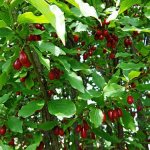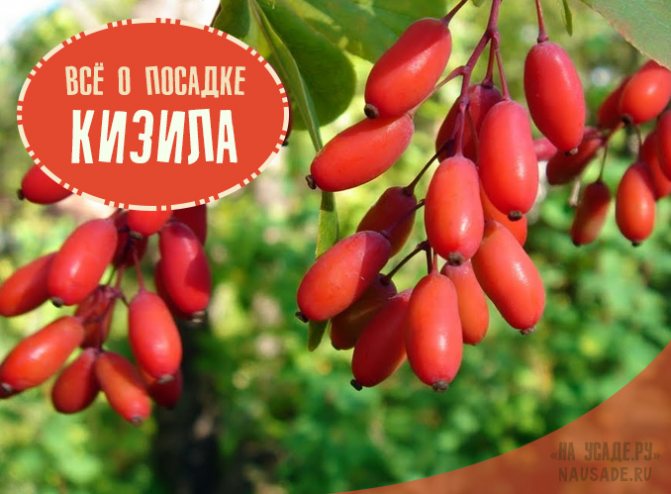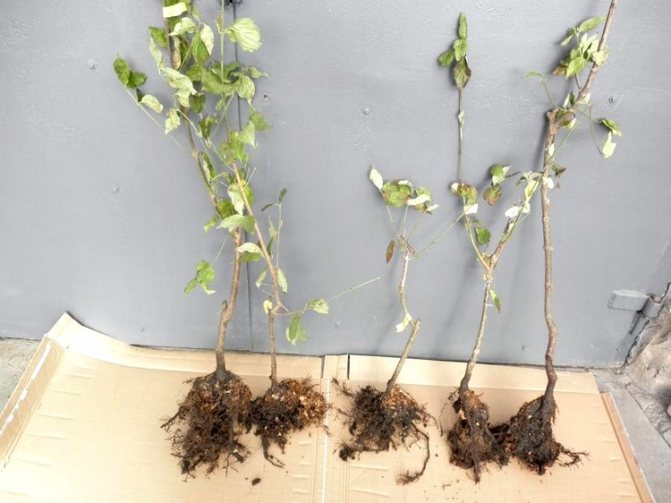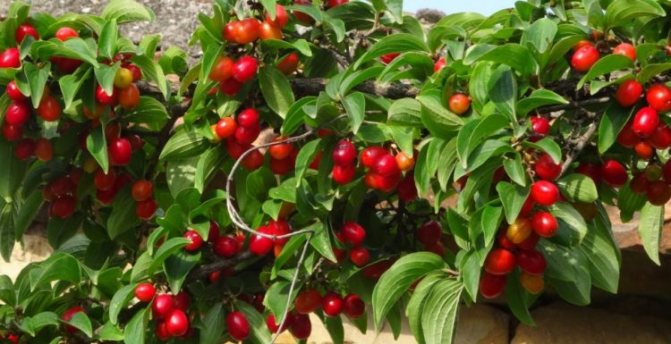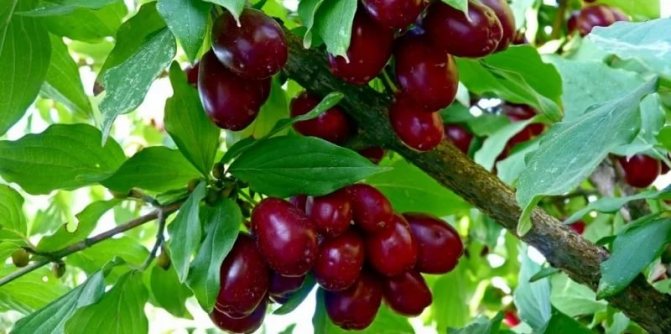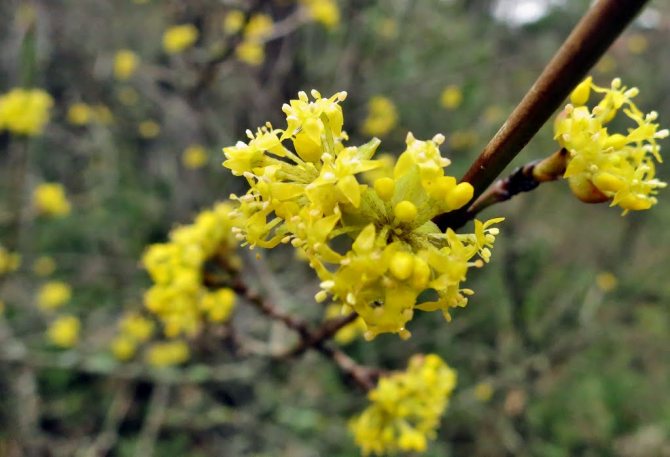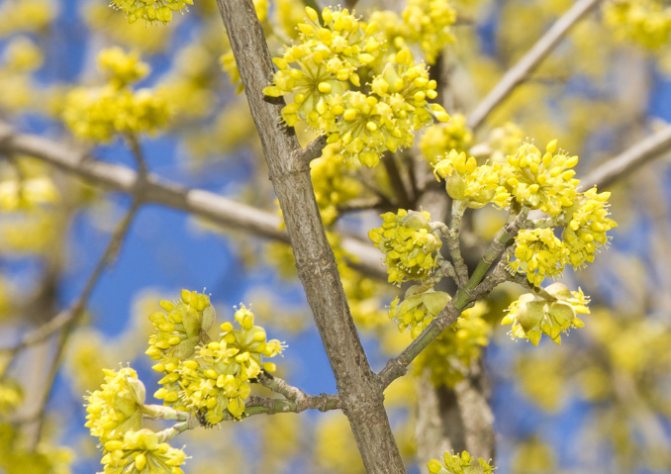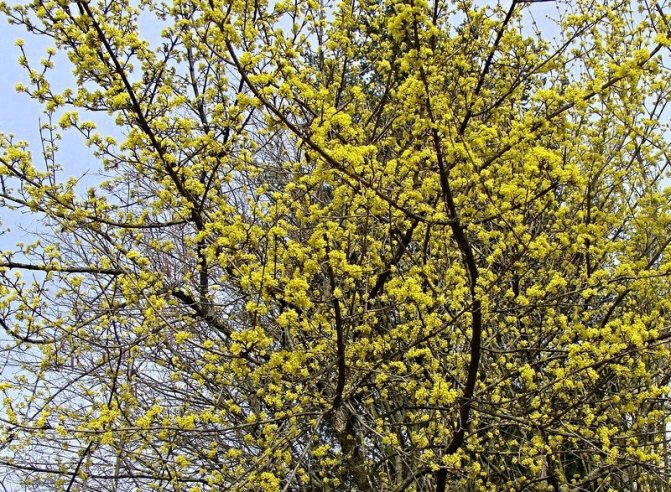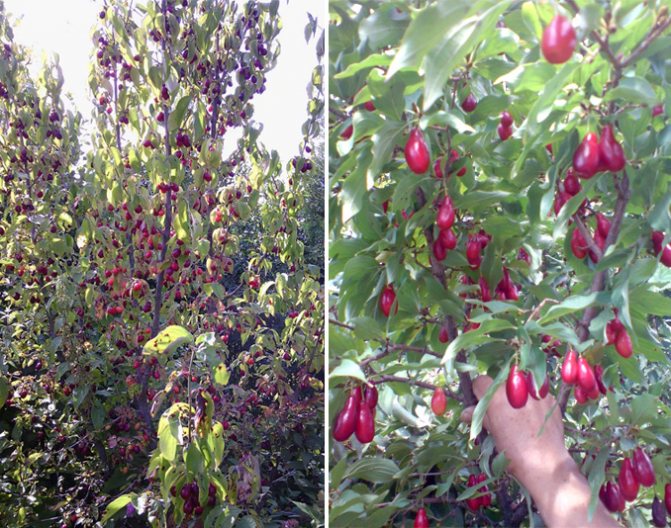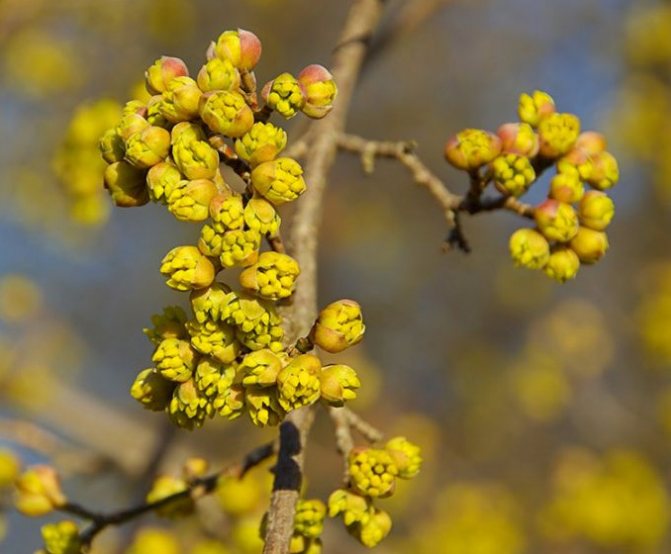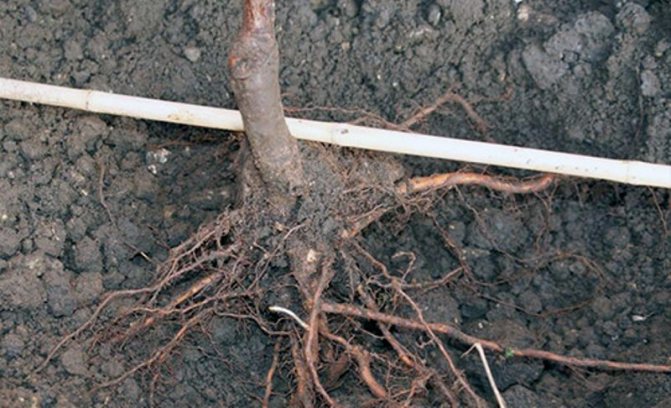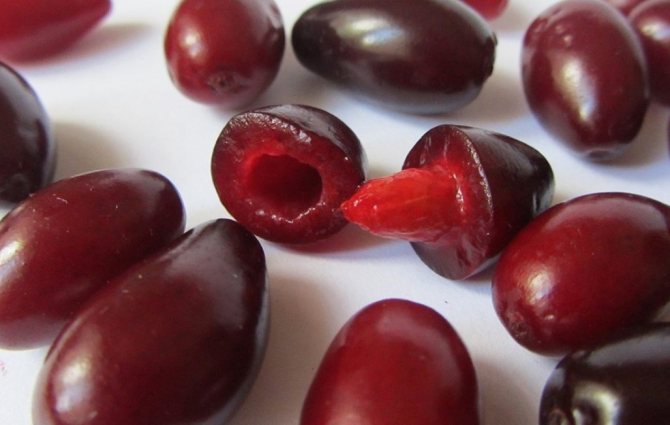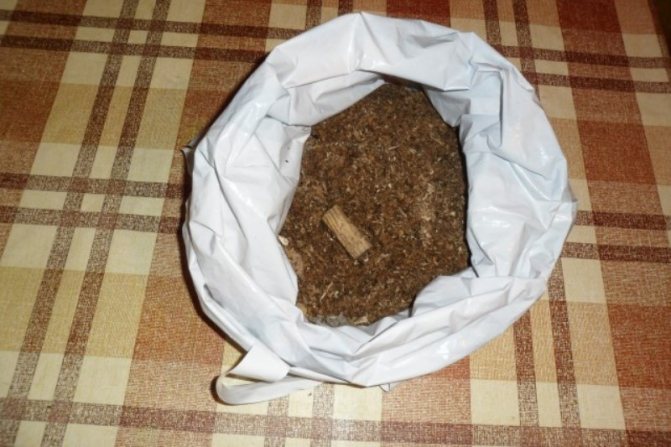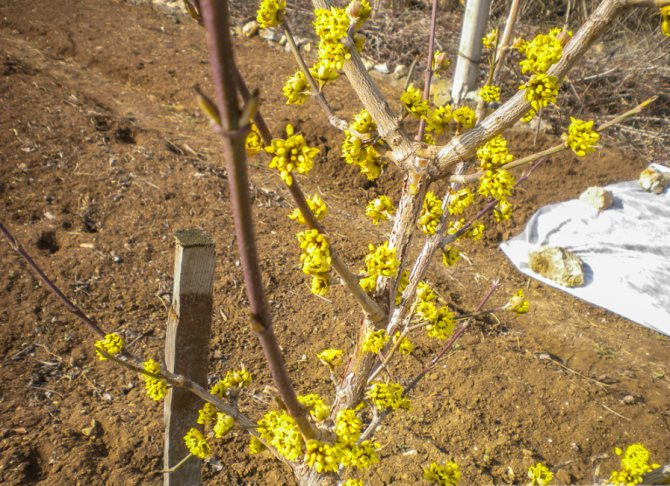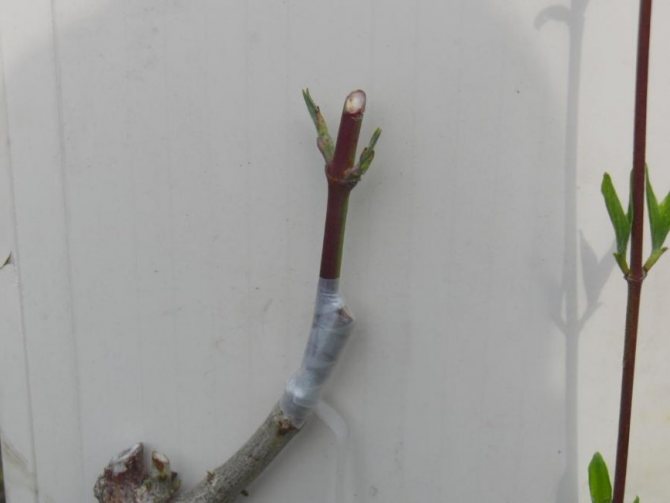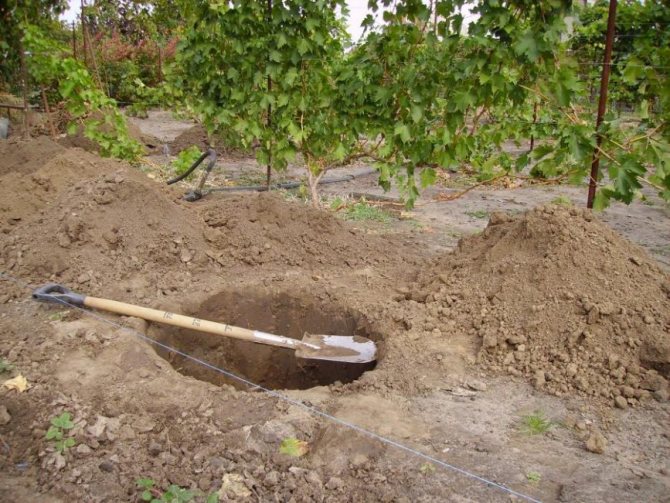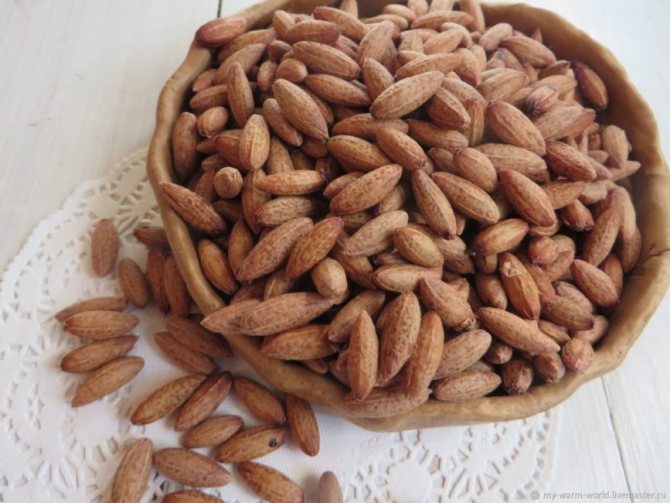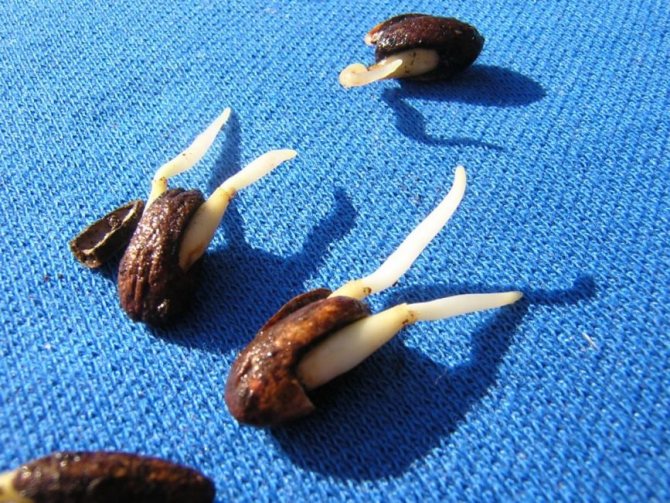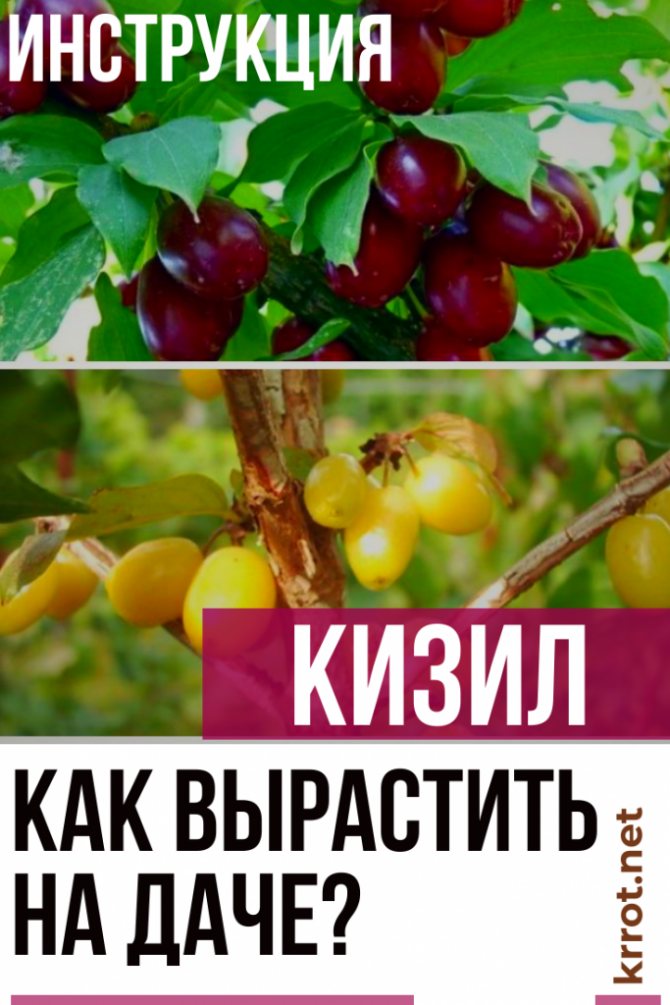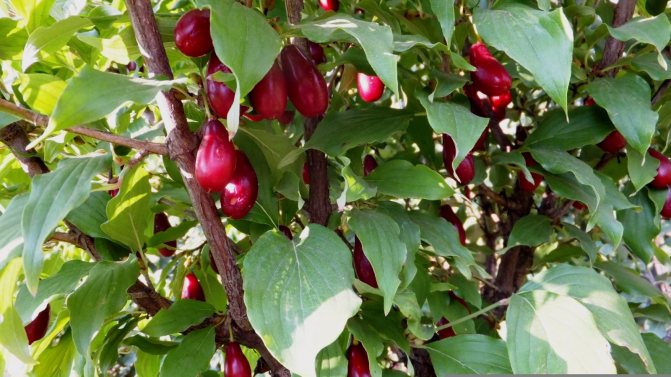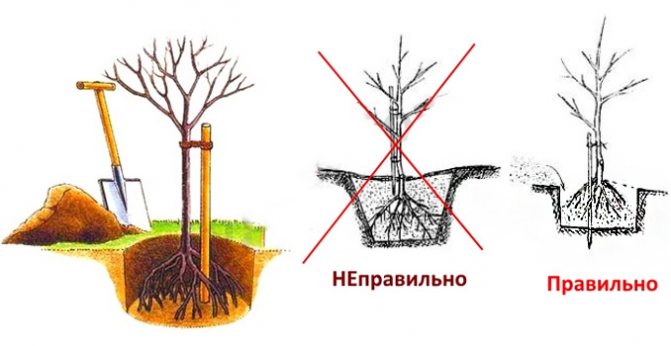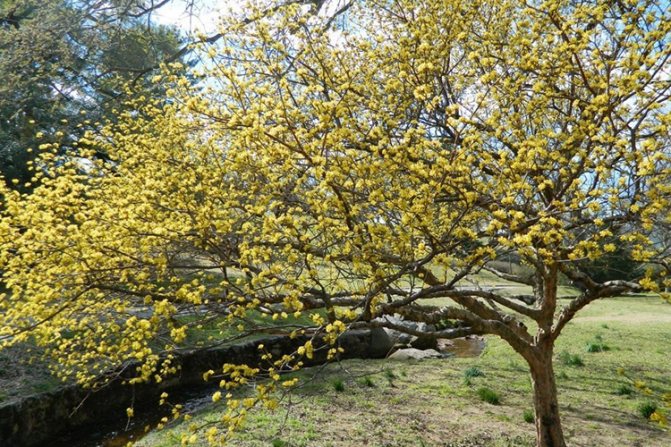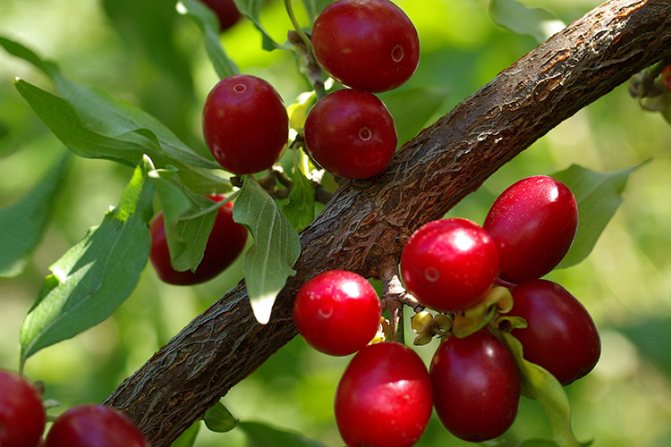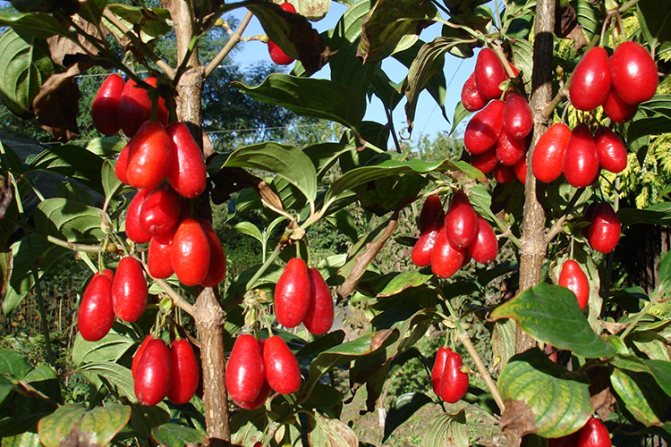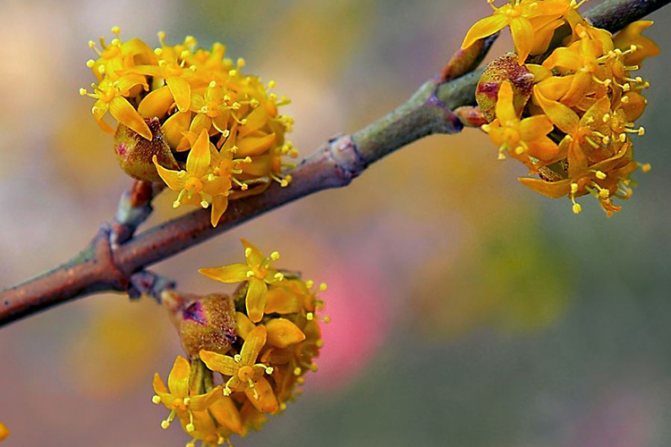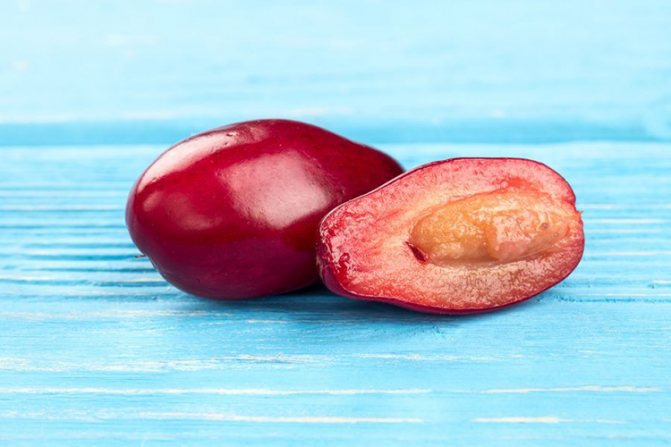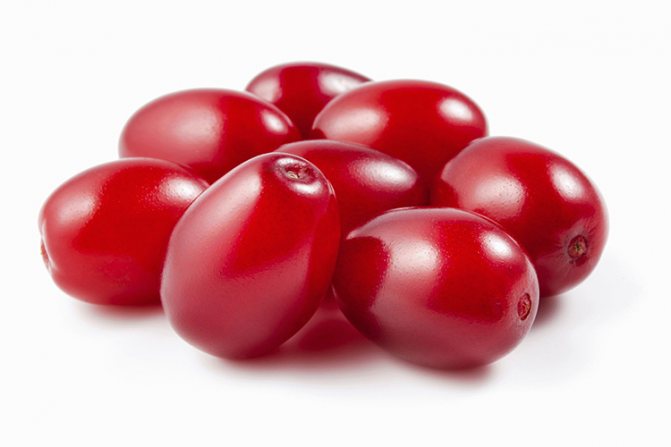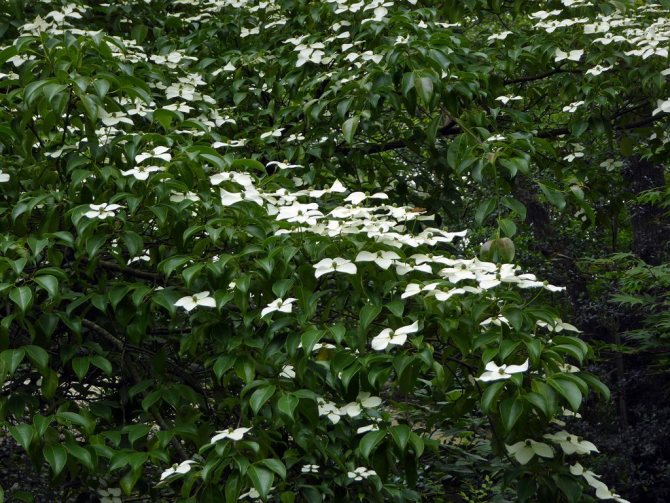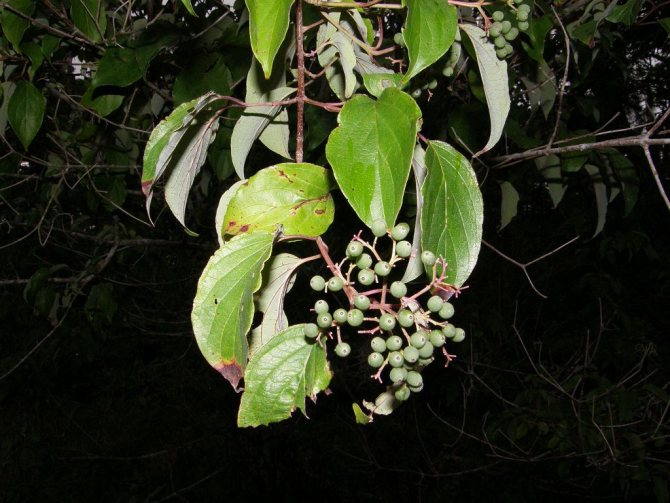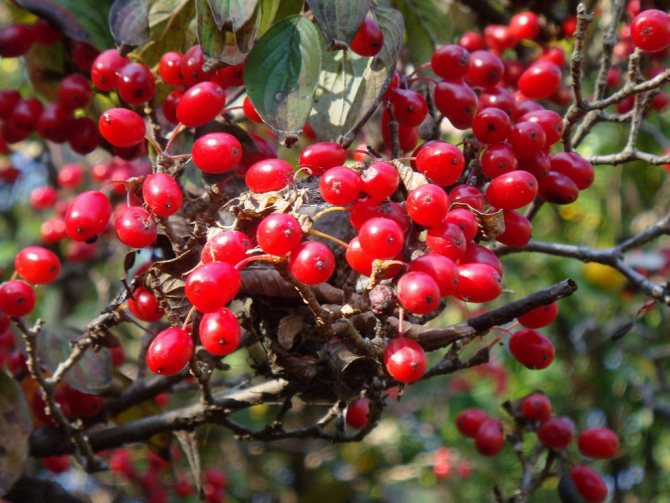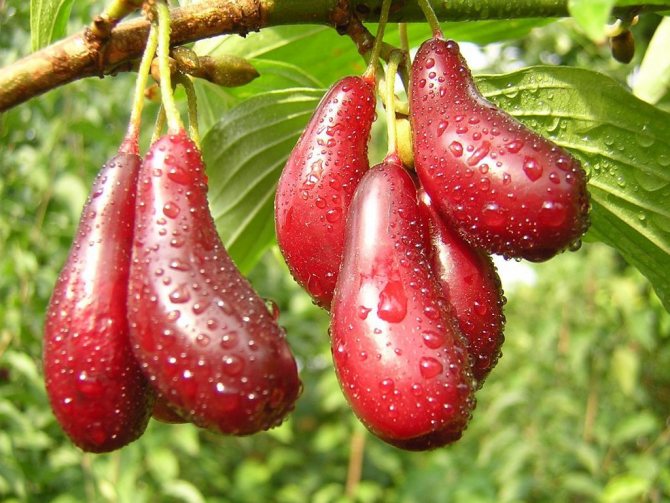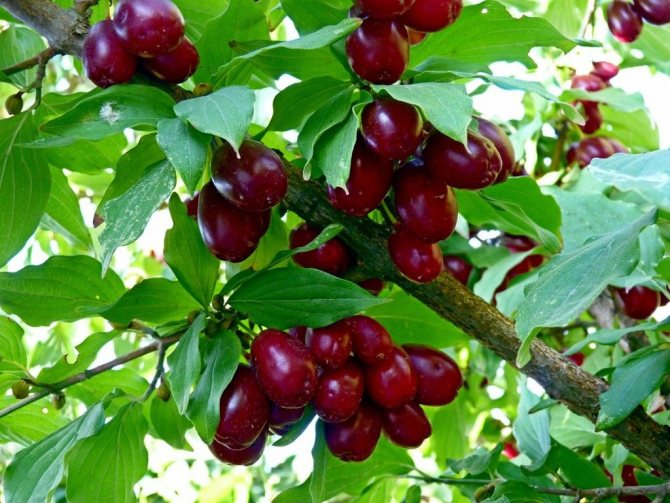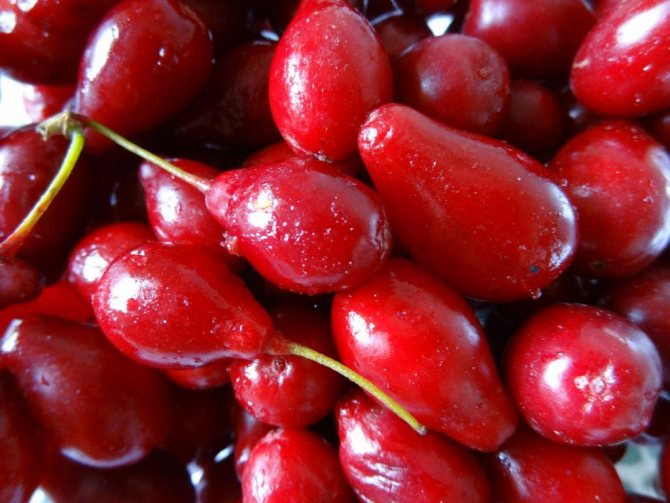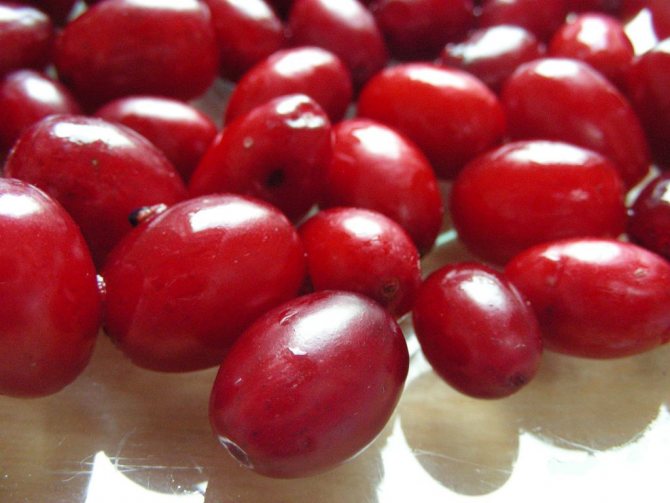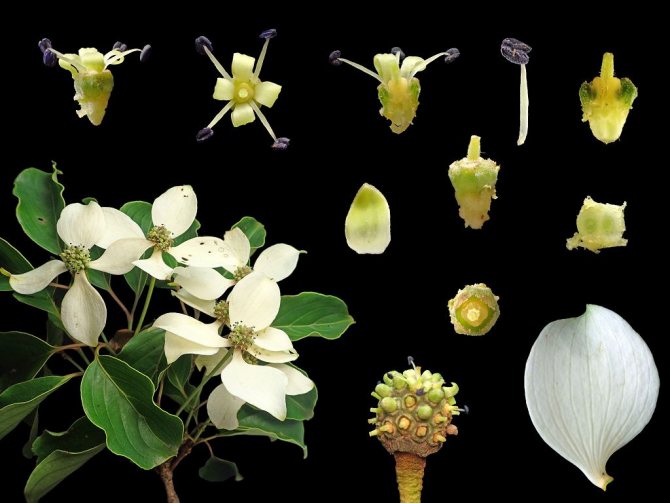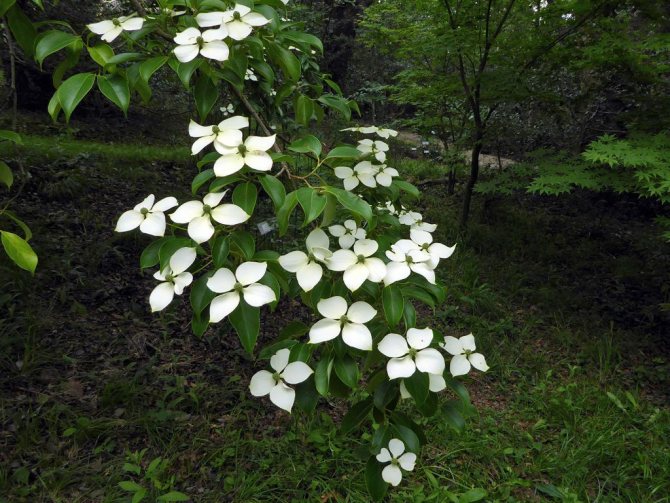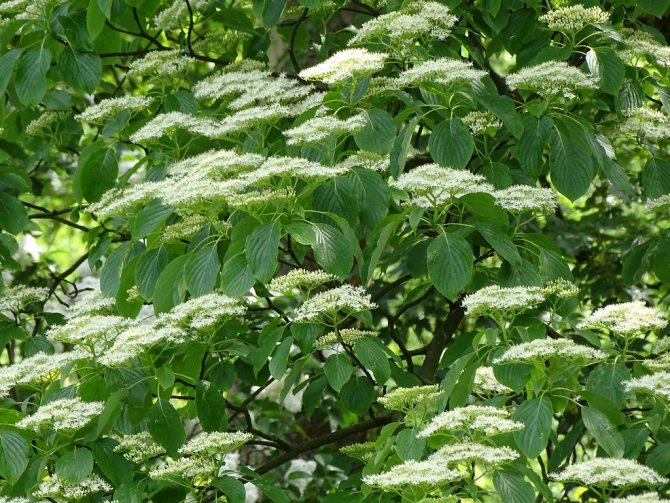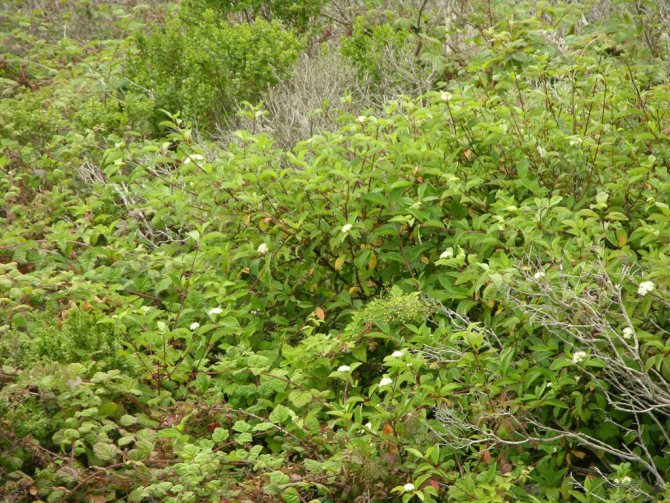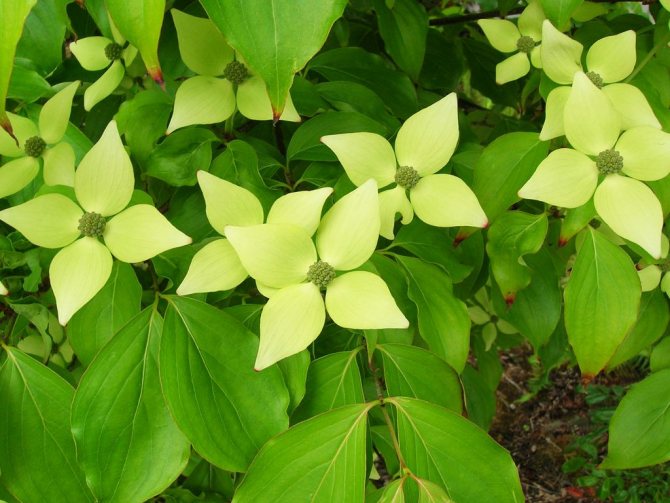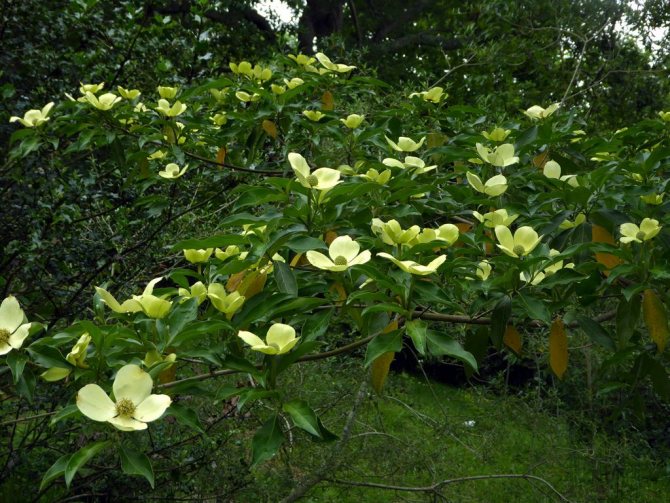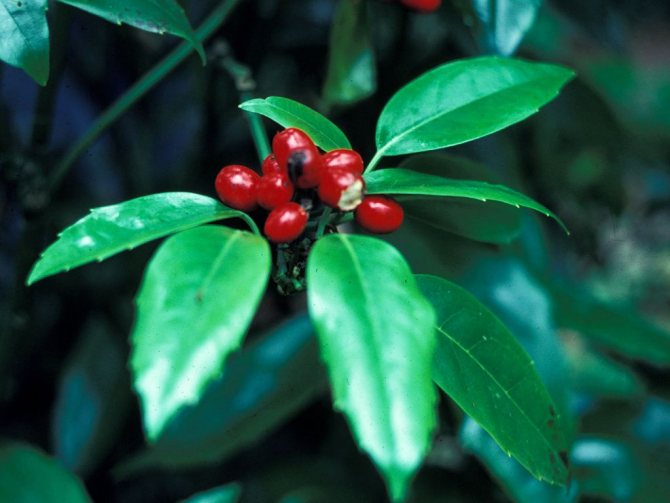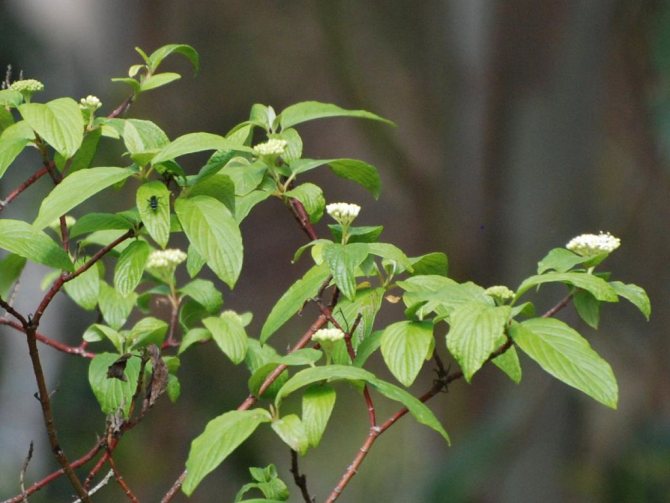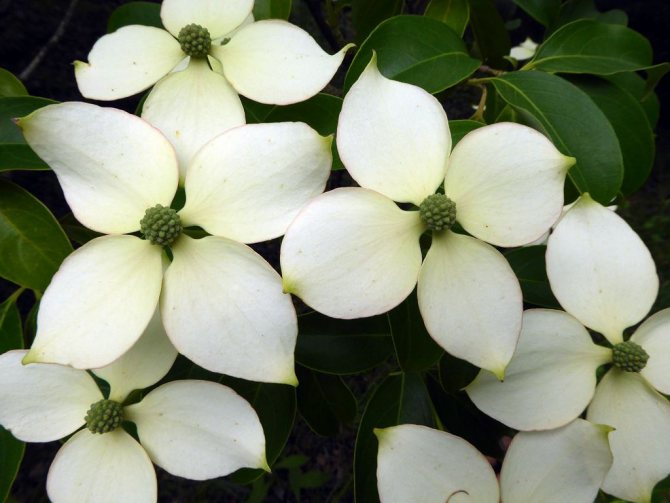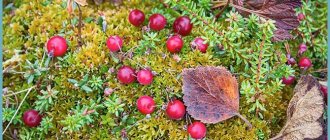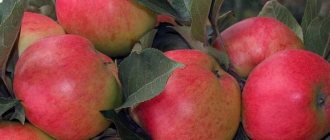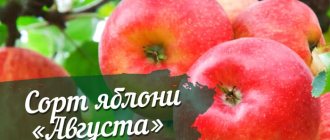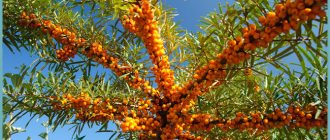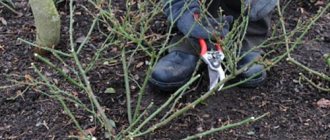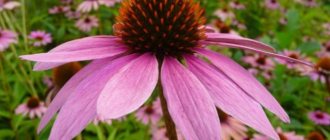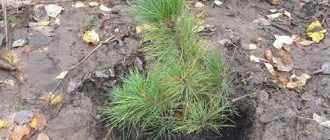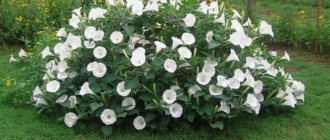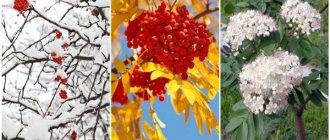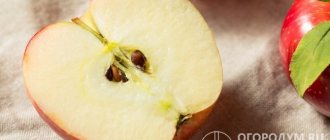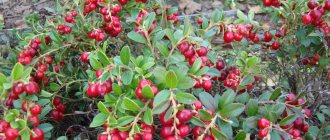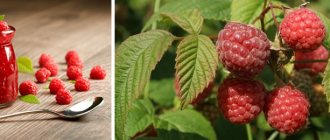Due to the high content of vitamin C, organic acids and essential oils, cornelian cherry has long been used for the treatment of vitamin deficiencies and the removal of heavy metals from the body. Dogwood copes well with skin diseases, hemorrhoids, anemia.
Dogwood is also appreciated for its special hardness and unusual decorative pattern of wood. And the shrub itself has a beautiful crown, lush yellow flowering in spring and bright reddish leaves in autumn.
This plant is unpretentious, does not require special care and regular feeding, grows well on poor soils. Dogwood lives for a very long time - three centuries! And all this time, even with minimal care, it pleases the owners with tens of kilograms of tasty and healthy berries.
The grafted dogwood seedlings give "signal" first fruits already in the second year of life, and from the age of 5 - an industrial harvest. Seedlings begin to bear fruit at the age of 8.
Description of the plant
The dogwood family has about fifty representatives of the species. The most famous common dogwood, also called male dogwood. It can grow up to 2.5 m. The dangling, shiny orange-red shoots, in contact with the ground, take root easily. The shrub blooms in May with white inflorescences for two weeks. Fruits ripen gradually in August-October. Usually the fruits are bright red with one or even two seeds. However, you can find varieties with yellow, pink, purple and black berries. The fruit tastes sweet or tart, and the aroma is pleasant. The plant is frost-resistant, but at -30 degrees frost, the tops of the shoots freeze. Dogwood can grow up to a hundred years old.
Cornel fruits are extremely useful for the body, being a storehouse for the content of trace elements and vitamins A, P, C. It is popularly used as an excellent astringent.
Dogwood care, cultivation
Cultivation conditions
They do not differ significantly from the cultivation of barberry, rose hips.
The plant prefers light, nutritious soil that is good for air and moisture permeability. Therefore, it is advisable to allocate well-lit and warm places for the bushes, preferably with a slight slope. Groundwater should be below 1.5 meters. The soil must be calcified. Cornel can grow on acidic soils, but then it develops slowly and does not give a good harvest.
A feature of the culture is the annual harvest, the laying of future fruits occurs in May-June with good nutrition. Cross-pollination is necessary, therefore, for a stable rich harvest, it is necessary to have several varieties in the garden. Several other varieties can be grafted onto one plant.
For good development of the bush, powerful growth of the root system, regular watering is required. Experts recommend making a groove around the plant so that water does not spread. Watering should be abundant, but waterlogging should not be allowed. Together with water, fertilizing is also added: at the beginning of the season, nitrogen-phosphorus, and from mid-summer - potash. Cornel reacts positively to calcium, wood ash, humus.
Planting dogwood
Planting in the ground to a permanent place is carried out with two-year-old seedlings with 3-5 skeletal shoots. To do this, prepare a planting hole up to 80 cm deep, and immediately it is worth driving in a stake for the seedling from the side of the wind rose.The upper soil from the hole is mixed with mineral fertilizers and compost and the hole is filled up to half with a mound. A plant is planted on top, well spread the roots, and covered with earth so that the root collar is 3-4 cm higher above the soil level. The seedling is watered abundantly with water (about three buckets per bush), the crown is cut by a third and tied to a peg. It is better to mulch the surface so that the trunk circle does not dry out.
Boarding time
Planting can be carried out in the fall during the period when the poplar begins to drop the leaf, but no later than three weeks before frost.
In the spring, planting is carried out when the buds begin to bloom and the soil warms up enough.
The distance between the bushes should be 3-5 m.
Crop pruning
In addition to sanitary pruning of dry and damaged shoots, the formation of a bush is also required. Regularly prune one third of the old branches, as well as the shoots growing inside the crown. All shoots growing below the graft are cut off from the grafted bush. Read on for how to properly prune fruit trees and shrubs.
dogwood care cultivation 1
Dogwood propagation
Amateur gardeners usually propagate vegetatively (by cuttings, layering, division). However, you can propagate by culture and seeds.
Breeding with green cuttings can be carried out from a bush at least 5-6 years old. Cut at an angle into segments 10-15 cm long with two pairs of sheets and a growth point. The cuttings are immediately placed in water, and then kept in a solution of heteroauxin (3%). Before planting, the lower leaves are removed, the cuttings are washed, planted in the ground and covered with foil for 4-5 weeks until complete rooting. The cuttings are periodically moistened and ventilated.
Top dressing of cuttings is carried out with a solution of ammonium nitrate. A year later, in the fall, the seedlings are transplanted to the desired place.
You can propagate a bush by layering - the simplest and easiest way. To do this, they dig up the soil under the bush, fertilizing it. A groove is made and the shoot is pinned. They constantly moisten the pinning site, and over time, the cuttings will take root and give rise to shoots. Next spring, you can already separate it from the mother plant and transplant it.
The division of the bush is carried out when it is transplanted to a new place, cutting it into equal parts. Before planting, old branches and roots are cut out of the delots.
You can propagate by shoots or graft the desired variety to the wild.
Cornel can also be propagated by seeds (bones), only their stratification is necessary. The seedlings grow slowly during the first years. And they will bear fruit no earlier than seven years of age.
Diseases and pests
The plant is resistant to disease. Only occasionally is rust damage (yellow spots on the leaves) observed. You can cope with the disease with Bordeaux liquid.
How to transplant an ordinary dogwood?
If there is a need to transplant a plant from one site to another, the technique of reproduction by dividing the bush is applied.
For one year, this method can be used in early spring or late autumn. The plant is removed from the soil and freed from old branches. The root is cleaned of soil, and the shrub is cut into several parts... The roots are trimmed, the old shoots are removed. After that, the individual parts are planted in prepared holes.
The common dogwood is a long-liver. It can produce excellent harvests for 100 years.... Therefore, if you plant a dogwood, it will delight more than one generation with its tasty and healthy berries.
Description of dogwood
Dogwood is winter-hardy to grow in the middle lane. In a botanical garden in Moscow, it has been grown since 1950 without shelter.
There is a popular sign - a large harvest of dogwood berries speaks of a cold winter.
Dogwood fruits are bright red berries with an oblong stone inside. There are varieties with yellow, purple and pink fruits. The shape of the berries can be from round to pear-shaped.
Several dozen varieties of dogwood have been bred. In some, the berry mass reaches 30 g.For comparison - in the wild, the weight of a dogwood berry is no more than 5 grams.
Dogwood is decorative throughout the season. In early spring, it blooms with clouds of golden flowers that bloom long before the leaves unfold. Long bloom - 20 days. Many bees gather on the flowers, hungry during the long winter.
With early flowering, dogwood fruits ripen late - at the end of autumn.
Harvesting and storage
Dogwood fruits ripen gradually. You can determine the degree of ripeness of the berries by tasting the berries. Ripe fruits have a pleasant sweetish taste with sourness, a dense structure. Overripe berries are soft, not suitable for transportation and storage. Slightly unripe fruits are harvested by hand and placed in containers. The collected berries are kept in small containers for 2-3 days for full ripening and sent for storage. Fresh berries can be refrigerated for up to 12 days. They are placed in plastic bags. Temperature range 0- + 2 degrees.
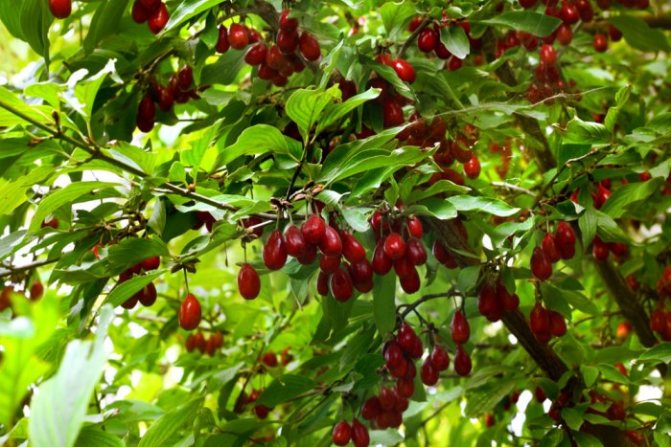
The vitamin composition of the product is well preserved when stored in the freezer of the refrigerator. Fresh berries, covered with sugar in a ratio of 1: 2, retain their beneficial properties. The product is stored in the refrigerator. Jam, jams, juice, compote are prepared from dogwood. In addition to berries, they use bark, leaves, cornel roots for the preparation of decoctions, tea, and tinctures. The bark is harvested in early spring, the leaves - during the flowering of the plant, the roots - in late autumn. For storage, they are dried and placed in paper bags.
Where does the dogwood grow
In the wild, the plant is in the Crimea, Moldova, the Caucasus and Transcarpathia. Its second name is male dogwood.
Despite its southern origin, dogwood tolerates temperate winters and sets fruit. In the area of St. Petersburg and even more so in the Urals, bushes require shelter for the winter. In some years, the berries do not fully ripen, therefore they sour.
In cold conditions, the dogwood does not reach the height that is naturally characteristic of it. Despite the difficulties with cultivation, summer residents of central Russia should not abandon the southern culture, since its fruits have medicinal properties.
Useful properties of dogwood berries for health
Knowledgeable people have long been using dogwood for medicinal purposes, because its benefits are colossal:
- strengthens the immune system and the body's defenses;
- characterized by anti-inflammatory, antipyretic and bactericidal effects;
- increases hemoglobin in the blood;
- normalizes blood pressure and vascular walls;
- used for diarrhea;
- restores metabolism, improves appetite;
- stimulates the work of the pancreas;
- useful in spring and off-season, when vitamin deficiency is observed;
- has incredible benefits for the intestines;
- promotes the elimination of toxins;
- has a choleretic effect;
- characterized by antimicrobial properties.
The dogwood berry is incredibly useful for ARVI and respiratory viral infections. Drinks prepared on the basis of dogwood fruits have antipyretic effects.
Preparing for planting dogwood
In the State Register, the culture is represented by the only Prikubansky variety. It is allowed for cultivation in all zones.
Prikubansky bush of medium growth with a spherical crown and straight shoots. The fruit has a sweet and sour pleasant taste. Prikubansky tolerates the winter of the middle zone without shelter. It is important that the variety reproduces well by rooting green cuttings.
In nurseries, dogwood is propagated by grafting. For rootstock, seedlings obtained from seeds of wild or cultivated dogwood are used. You cannot graft dogwood on stone fruit crops - cherries, plums and apricots, since stone fruits have nothing to do with it.
For planting, summer residents use annual grafted seedlings with a developed root system. A varietal seedling is grown for at least 5 years, so the price of the planting material is rather high.
Dogwood requires cross-pollination to obtain stable yields, so the bushes are planted close to each other. The site will require at least two or three plants. The distance between the bushes is 3-4 meters. In dogwood orchards, cultivar strips of three to four varieties are created.
Planting dogwood
In the south, dogwood is planted in autumn, in the middle lane - in early spring, before bud break.
Cornel is a symbiotic culture. For normal growth, it needs a specific microflora, so the seedling must be with a closed root system. Saplings with "bare" roots, due to the lack of native microflora, lag behind in growth and development.
Cornel is grown on light fertile soil with a ph level of 5.5-6. The culture does not tolerate stagnant moisture. A bright place is chosen for her, from which snow melts early in spring. A site in a lowland where melt water and summer precipitation accumulates is not suitable.
Planting dogwood seedlings is carried out in the same way as planting other fruit crops. The soil is well dug in the fall, weeds, especially rhizomes, are removed.
The planting hole is dug in the spring. Its diameter and depth should be in accordance with the volume of the root system. It is important that the roots when planting are located in the soil without bends and creases.
Before planting, broken bricks or other drainage is poured into the bottom of the pit with a layer of 4-5 cm. The drainage is covered with fertile soil mixed with wood ash 1: 1. The seedling is planted so that the grafting site is at the soil level. After planting, the soil is compacted and watered, then mulched with peat or humus.
Dogwood pests and diseases
Damage to dogwood by sucking and gnawing insects is sporadic, because there are no large-scale plantations in our area. The dogwood butterfly does not bypass its attention, whose caterpillars "chew" the leaves. In the leaves themselves, the caterpillars of the pointed-winged moth can live. They are so small that they are invisible to the naked eye, and they live inside the leaf. Their presence is indicated by light stripes on the leaves. Micro-moth butterflies lay eggs during the period of flower formation, and hatched caterpillars in summer are mistaken for juicy berries. To get rid of caterpillars will help spraying with insecticides Aktara, Akarin, Fitoverm in accordance with the instructions or a harmless biological product Dendrobacillin (0.5 g per 1 m2).
Photo gallery: dogwood pests
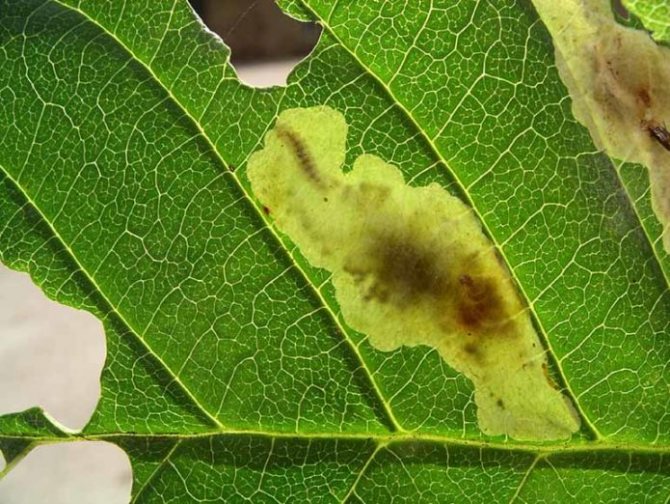

A pointed-winged moth caterpillar settles inside a leaf
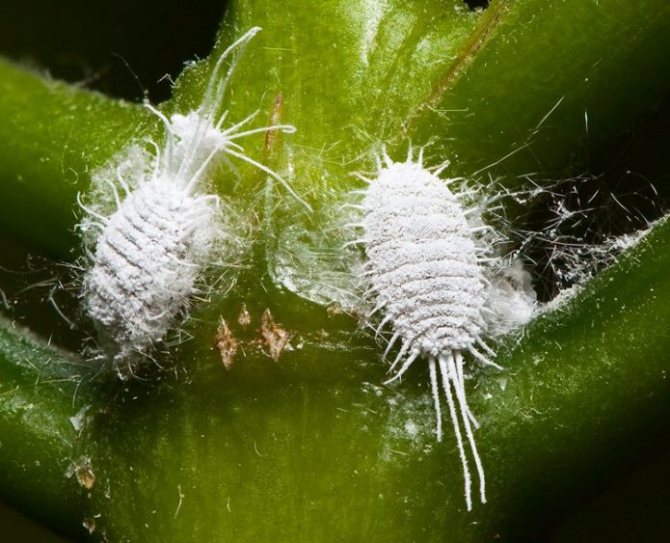

Small worm can do a lot of damage
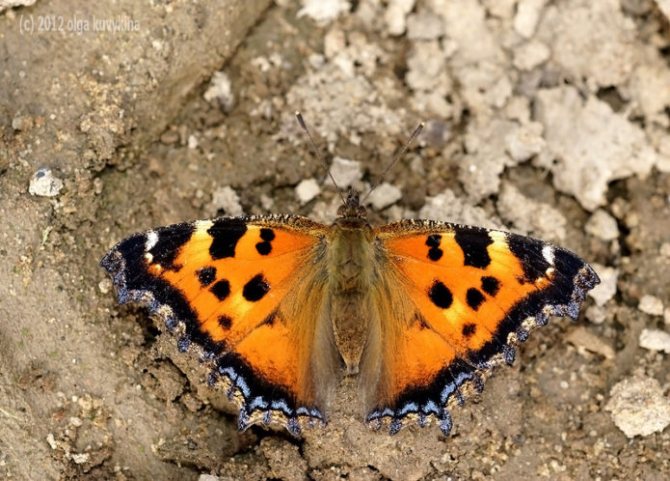

Caterpillars of the polychrome butterfly eat the leaves
Snail worms, whitish wingless insects, live in Septobasidium - mushrooms-epiphytes, similar to lichens, on dogwood branches. But, if the mushroom uses the dogwood as a support, then the worms, crawling out of it, suck the juices from the young twigs. Because of this, the shoots are bent, the ovary falls off. Spraying with lime is carried out against the worm (1-2 kg per 1 bucket of water). Lime will additionally protect the plant from overheating and sunburn.
When spraying plants with a lime solution, small holes of a conventional sprayer are clogged with lumps of lime, and therefore it is better not to use it. It is more convenient to make a special baffle plate for the sprayer - a plank. Striking the flap, the jet will take a fan-shaped shape, and the calcareous liquid will lie in an even layer on the plant. When working with quicklime, use glasses.
Voropaev M.S.
Traditional diseases of dogwood include:
- powdery mildew - white bloom on all parts of the plant, mostly young bushes are sick;
- rust (usually appears in the middle of summer) - leaves become covered with yellowish and rusty spots that interfere with the process of photosynthesis, lead to the death of leaves and worsen growth;
- necrosis - a fungus pathogen, multiplying on dead branches, affects weakened and damaged shoots.
Photo gallery: signs of dogwood diseases
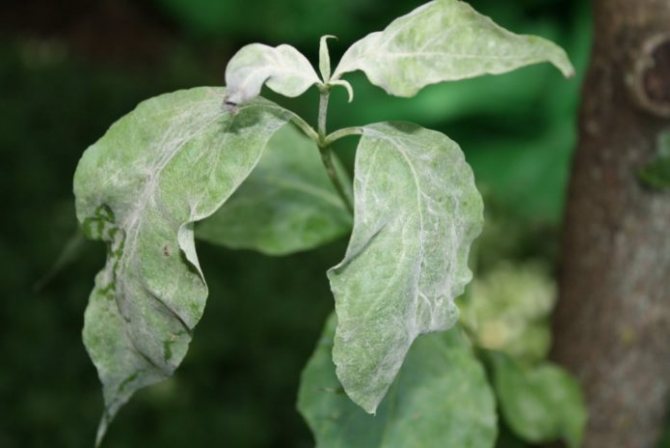

Regular inspection will detect powdery mildew at an early stage
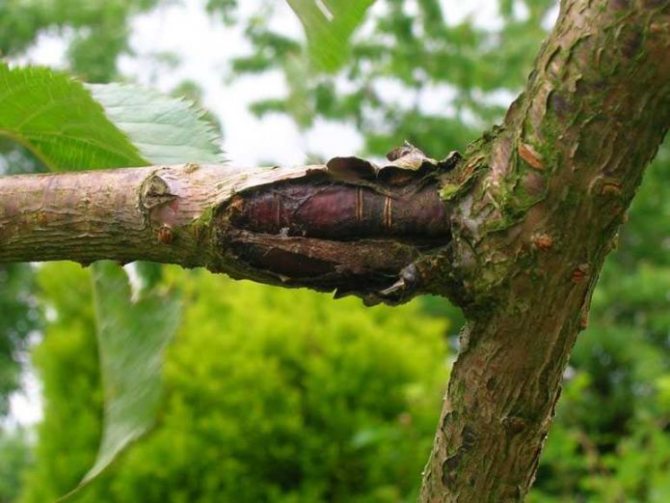

Tree necrosis is treated with amputation
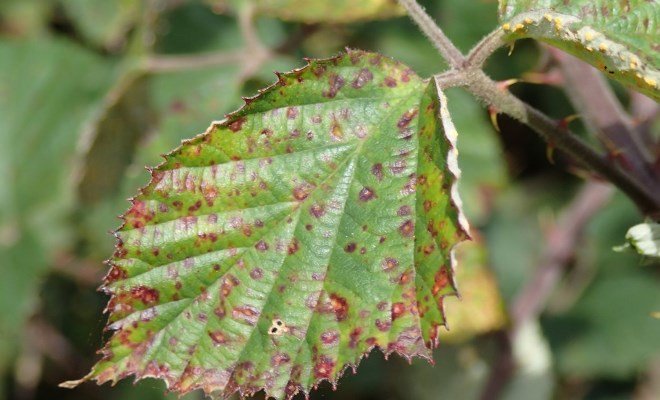

The age of the rusty leaf is short
In the fight against powdery mildew and rust, spraying with a 1% solution of Bordeaux liquid with an interval of 15–20 days will help (the last treatment is 20 days before harvest). The affected parts of the plant are removed and burned. Another option for spraying rust will be rotted cow dung:
- Pour manure with water in a ratio of 1: 5.
- Insist in a closed container for 1.5–2 weeks, stirring once every 3 days.
- Strain the finished solution (it is ready when the liquid brightens and fermentation is over).
- Dilute by half with water.
Timely pruning and incineration of waste will be the prevention of necrosis and a measure to combat rust and powdery mildew.
When the dogwood bears fruit after planting
A dogwood seedling begins to bear fruit at 8-10 years. A grafted seedling will give signal fruits already in the year of planting, tying at least one inflorescence. At the age of five, the plants will give a full harvest.
The berries ripen by the beginning of autumn. Dogwood gives a rich harvest - it seems as if the bush is strewn with fruits.
The fruits are harvested without waiting for shedding. You can spread the burlap under the bush, shake the bush, then collect the fruits from the fabric and separate them from the debris.
The absence of diseases and pests on the dogwood guarantees the ecological purity of the crop.
Dogwood: planting, growing, care
What associations do you have with the name "dogwood"? I immediately remember the jam that my roommate from Karachay-Cherkessia treated me to during my student years. This is not just a jam, this is a pure delicacy. Cornel is not only tasty and is used in the preparation of jams and various dishes, but also has a wide range of nutrients that improve blood pressure and aid digestion. In Crimea, there are various legends in this regard, which say that any disease can be cured with the fruits of dogwood and a decoction from it. In the Caucasus, nutritious dogwood lavash helped to avoid scurvy during the First World War.
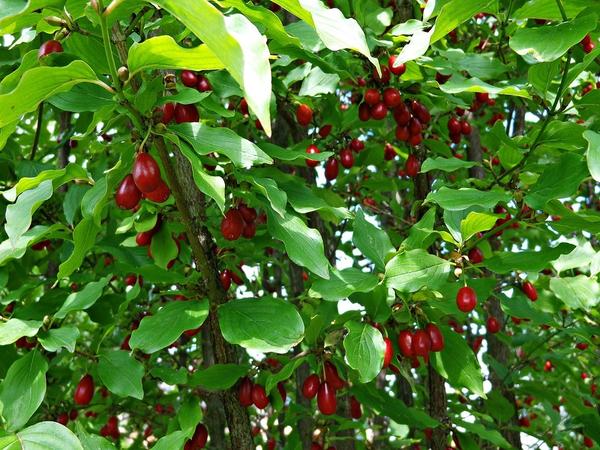

Dogwood
It is problematic for residents of middle latitudes to have such a "handsome" in their garden, although the plant itself does not require special care. The thing is that the dogwood begins to bloom earlier than other plants, but its growing season is about 250 days in a warm climate - for example, in the Kuban. Therefore, for middle latitudes, you need to acquire a variety with an early ripening of fruits.
Cornelian cherry belongs to the Cornelian family, represented in the form of shrubs or trees not exceeding 8 m. You can meet it freely growing in the Crimea, Transcarpathia and the Caucasus - in thickets, undergrowth or forest edges. Dogwood has been living for over 100 years. In our country, common dogwood (Cornus mas), or, as it is also called, male dogwood.
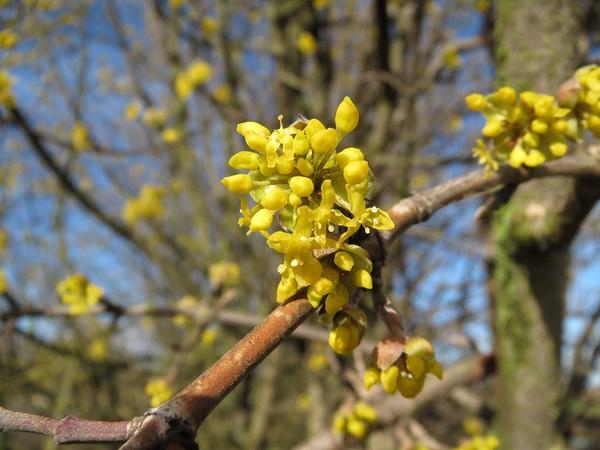

Cornelian cherry flowers
The berries of the common dogwood are bright red (during the selection process, varieties with amber-colored berries were bred), fleshy, inside the drupe.
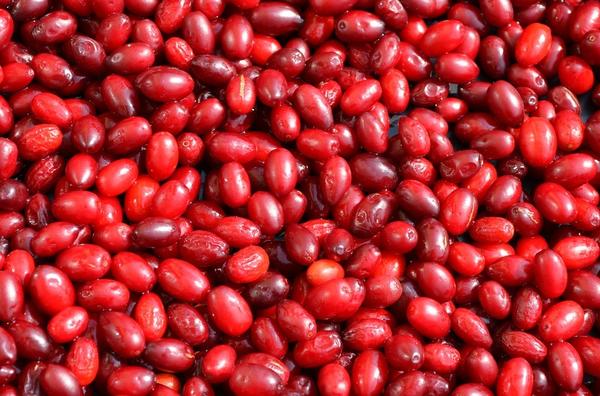

Dogwood fruit
Dogwood tolerates frost well, but at -30 ° C, branches are damaged. Therefore, young dogwood plants require good shelter for the winter. If the temperature is slightly higher than +40 ° C, the leaves on a young tree may dry out, in this case, the first years of life in the garden, the dogwood is shaded with sunflowers, corn.
Calorie content and chemical. composition of berries
Irga description, cultivation and useful properties
Cornel berries are low-calorie foods, which are completely free of fats (only 45 kcal per 100 g of fruits) and carbohydrates, which carry energy value, predominate.
Important! In addition to the main components, the berries contain tannins (they give a tart taste), which are able to resist many inflammatory processes in the body.
BJU of fruits (per 100 g) is:
- proteins - 1 g;
- fats - 0 g;
- carbohydrates - 10 g.
Such characteristics make it possible to include berries in the dietary food menu.The composition also contains a high content of vitamin C, which is a stimulant for the immune system, and vitamin PP, which has a positive effect on the human cardiovascular and digestive systems.
Among the nutrients are micro and macro elements such as K (potassium), Mg (magnesium), Ca (calcium), P (phosphorus), Fe (iron), Na (sodium), S (sulfur), Se (selenium) , Zn (zinc), as well as pectin, malic acid and disaccharides.
Planting dogwood
As I said, dogwood is a southerner, he loves a warm mild climate. But don't despair in cooler climates. You just need to more accurately choose a variety that can take root in your region. Once upon a time, grapes grew only in the south, and now in Oryol my parents grow beautiful black grapes without warming or covering it for the winter.
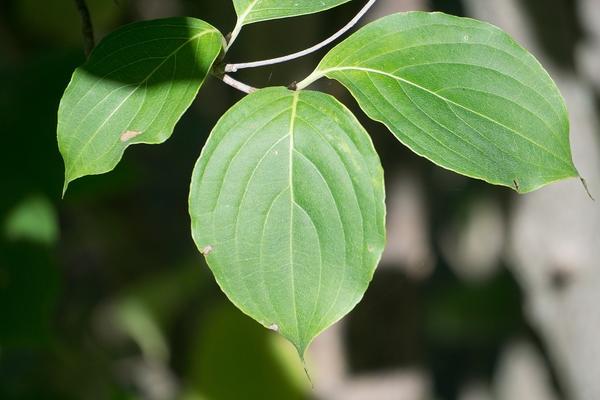

Dogwood leaves
Cornelian cherry grows well on soils rich in lime. In principle, he does not like acidic soils, but he can even grow on them, however, this will affect the development of the plant and the yield. Groundwater should be no closer than 1.5 m from the surface of the earth.
When planting, choose a south or southwest side. Plant in fall. It is believed that if the foliage of the poplar began to fall off, then it is time to plant the dogwood.
- The depth and diameter of the planting pit should be about 60 cm.
- Drive the stake from the side where the wind is blowing, and put the seedling on the opposite side, straighten the roots.
- Make the root collar 3 cm above ground level, so that when the ground has settled, the collar is flush with the ground.
- When digging a hole, place the top soil and the bottom in opposite directions. Mix the upper fertile layer with humus and mineral fertilizers and cover the seedling, pour 2 buckets of water and mulch the soil with humus or dry soil of the lower layers.
There should be at least 5 m from the fence to the dogwood, arrange it in such a way that in subsequent years it is provided with good nutrition from the soil and other trees do not interfere with it, otherwise after 20 years the crown of the dogwood will thicken and narrow, which will have a qualitative effect on the amount of the crop.
Cornel is an excellent honey plant, but, as I said, its flowers appear early (flowering lasts about 2 weeks), when the air temperature is about +12 ° C, and for pollination by bees, the temperature regime should be much higher. Therefore, the dogwood must have a pair in the garden, and preferably two, so that the wind can transfer pollen from one tree to another and thus the trees can pollinate each other. At the same time they are placed at a distance of 3-5 m.
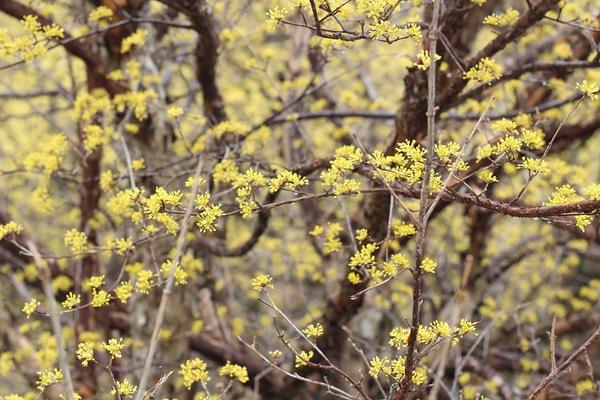

Dogwood flowers bloom early
A dogwood seedling, ready to plant, should be 2 years old, about 1.5 m high, about 2 cm in diameter and have about 5 skeletal branches. After planting, it is necessary to cut the shoots by 1/3. Although many gardeners do not do this in the first year after planting, the plants also take root well.
Botanical characteristics
Cornel is a perennial plant that can live up to 100 years. It is a deciduous woody shrub or tree up to 9 m high. Evergreen herbaceous plants are rarely found in the genus. A thin fibrous rhizome is located mainly in the upper layers of the soil. Smooth stems are covered with reddish-brown bark. Young, they easily lean to the ground, and when they come into contact with the soil, they put down roots.
Short-petiolate leaves grow oppositely, only sometimes alternately. They have an oval or ovoid plate with raised parallel veins. The color of the foliage is green or dark green. The sides are solid, the edge is pointed.
Already at the end of March, before the leaves appear, yellowish or milky-white flowers bloom. They are collected in dense inflorescences about 5 cm in diameter, which remain for 2-3 weeks. The corolla consists of 4 loose petals and a small but lush core. Cornel is recognized as a good honey plant, but during the flowering period the average daily temperature rarely exceeds + 12 ° C.This makes pollination difficult by insects. For wind pollination to be effective enough, it is necessary to plant several plants nearby with one flowering period.
The fruits ripen for a long time. Throughout the summer, they hang on branches in green bunches, and only from the end of August, or even closer to October, they become light red or maroon. In some species of dogwood, the berries are blue-violet or white. They are usually elongated or cylindrical in shape, but are nearly round or pear-shaped. The taste of a large (up to 3 cm in length) drupe is sweet and sour, tart. There is a single large bone under the thin skin and tender pulp.
Dogwood propagation
Dogwood can be propagated by seed or vegetatively. When propagated by seeds, their stratification is necessary. To do this, the drupes are cleaned of pulp and placed in wet sawdust or moss, constantly moistening them (the period of stratification is about a year). The peculiarity of the drupe of this plant is that it does not disintegrate into cotyledons, therefore, when planting, it should be deepened no more than 3 cm, then a hole appears in the bone through which the sprout makes its way to life. You can sow seeds without stratification, in this case they will sprout in two years, but the seedlings will appear unevenly.
With vegetative propagation, propagation by green cuttings, layering and grafting (budding) is more effective, take a two-year-old seedling. Vaccination should be done at dawn with fresh eyes. I have already described this method several times. You can see it in my articles about apple, pear, etc.
The ‘Yantarny’ variety was obtained by budding, whose fruits are yellow, not red, as we are used to seeing in the dogwood.
It propagates by layering in the same way as most fruit and berry plants. Horizontal grooves are made near the tree, the shoot is laid in them, pinned to the ground and sprinkled with earth, moistened. During the summer period, the branch should acquire roots, then it can be safely separated from the mother plant.
Hardwood cuttings take root very poorly, sometimes it takes about 2 years before a seedling can be planted in a permanent place.
Attractive cotoneaster touches
For the first time the plant was described by the Swiss biologist K. Baugin and gave it a name, which is translated into Russian as "quince" or "similar". The thing is that the leaves of some species and varieties of cotoneaster resemble quince fruits. The rest of the shrub has its own unique touches of attractiveness. The plant is widespread in North Africa, Eurasia, China and even Siberia. Therefore, some of its varieties are highly frost-resistant.
Describing this unpretentious shrub, we immediately note its extraordinary constancy. He is able to delight his fans for about 50 years in one place. For some, this is comparable to a lifetime.
Depending on the variety, cotoneaster is evergreen and deciduous. The plant is especially attractive in autumn, when its miniature egg-shaped foliage acquires bright shades. During flowering, brushes appear on the bushes, consisting of small buds of pink and snow-white color. Over time, in their place, original green fruits similar to miniature apples are formed. At the end of August, they acquire a new color, which corresponds to the species:
- the black;
- red;
- redhead;
- Orange;
- coral.
Inside the "apple" there are several seeds (from 2 to 5 pieces). The unique root system of the cotoneaster is located practically on the ground surface. Therefore, the plant is planted on slopes to retain the topsoil. Depending on the variety, the crown of the cotoneaster can be either creeping or erect. Some of them grow in the form of compact trees, not exceeding 10 m. The cotoneaster does not need additional watering.It is enough just to wash off the dust from it, if it does not rain for a long time.
Dogwood care
The formation of the crown and pruning of the dogwood consists in the designation of a stem of about 50 cm and 5 skeletal branches in the seedling, adhering to the shape of a bush. Thickening shoots and shoots are removed. Pruning may not be carried out in subsequent years. To rejuvenate the dogwood, a rejuvenating pruning is done at the age of about 20 years by cutting off 4-year-old shoots. Due to this, many new young branches are formed. For landscaping, many gardeners carry out pruning in various shapes.
Caring for dogwood consists in weeding, loosening the soil to a depth of about 10 cm, drip irrigation and watering in the first growing year.
Dogwood varieties
Dogwood varieties are varied in color, taste, and fruit shape.
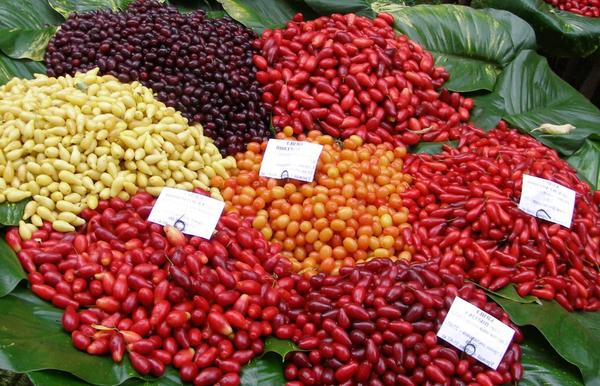

Dogwood varieties. Photo from the site
Below are some interesting, in my opinion, dogwood varieties:
Dogwood ‘Amber’
Variety with yellow fruits. When this variety is ripe, the color becomes so transparent-amber that even a drupe is visible. Fruits are about 3 g. Oval shape. Ripens in September, but crumbles when it reaches full maturity, therefore, a couple of days before full readiness, the fruits are removed, and they ripen already removed.
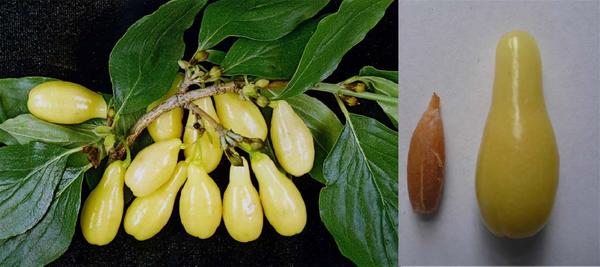

Dogwood ‘Amber’.
Kizil ‘Vladimirsky’
Large fruits weighing about 8 g. Fruit color is black-red, oval-cylindrical shape. The pulp is sweet and sour, with a fairly dense structure. The fruits do not crumble, are excellent in freezing and processing, ripen at the end of August.
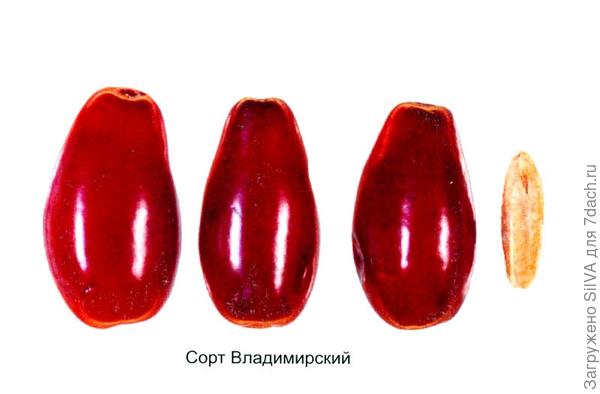

Cornelian variety 'Vladimirsky'
Dogwood ‘Firefly’
Fruits weighing about 8 g. When fully ripe, black-red, unusual bottle shape. The bright red pulp is very aromatic, has a sweet taste with sourness. At the end of August, you can harvest, it will be perfectly stored, the berries do not crumble. Ideal for processing and freezing. The crown of the tree is pyramidal, the annual yield, even for a 20-year-old tree, will be 60 kg.
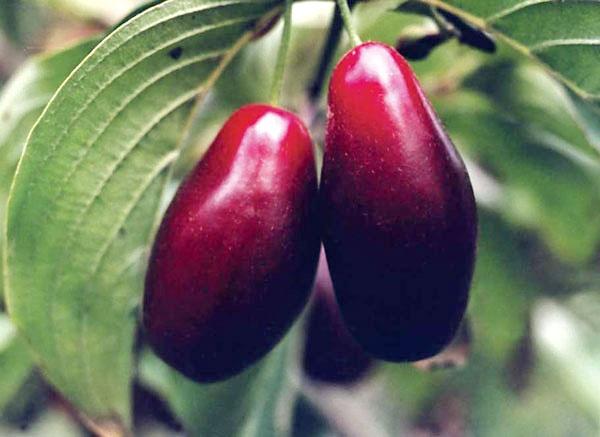

Dogwood ‘Firefly’. Photo from the site https: // en.
I adore William Pokhlebkin, as a historian, a person who proved that vodka was first made in Russia for the first time in the world. And not the one that intoxicates and destroys people. And the one that does not cause a hangover in the morning, and the state of the body does not cripple. But this is not about that, but about the fact that in his book of national cuisines I really liked the following recipe with dogwood, now with meager culinary abilities, I think if I can implement it and where to get dogwood in our places.
Harm and contraindications
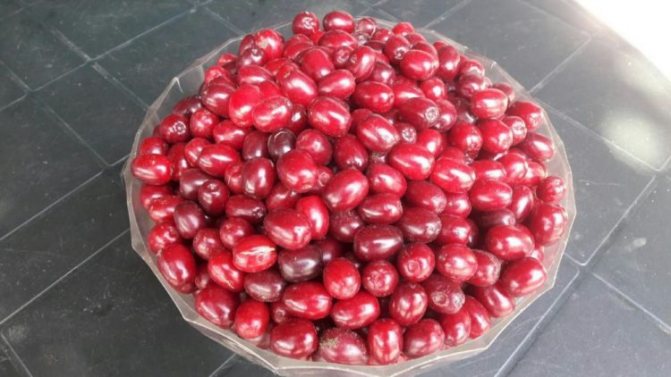

Cornel, the photo of the berries of which you will see below, has practically no contraindications, and there are no serious prohibitions (like allergies) to its use at all.
Still, it is not recommended to use dogwood products for people with high acidity of gastric juice, suffering from insomnia, chronic constipation and excessive nervous excitability.

